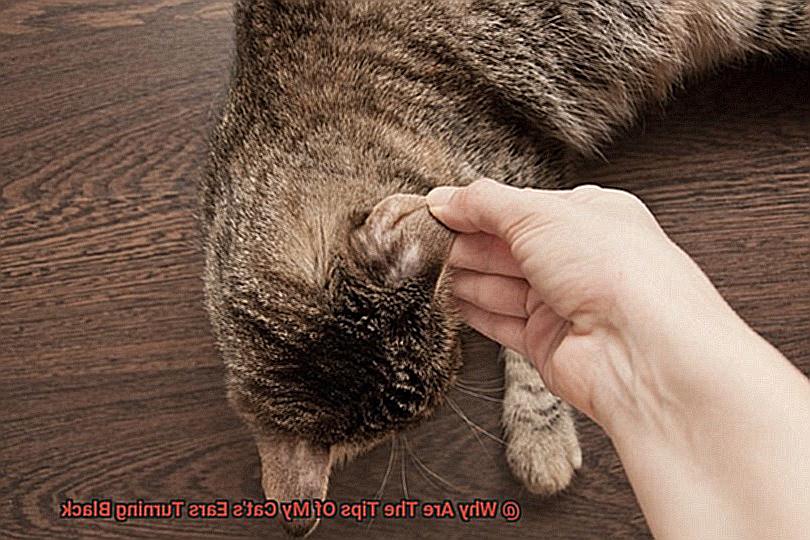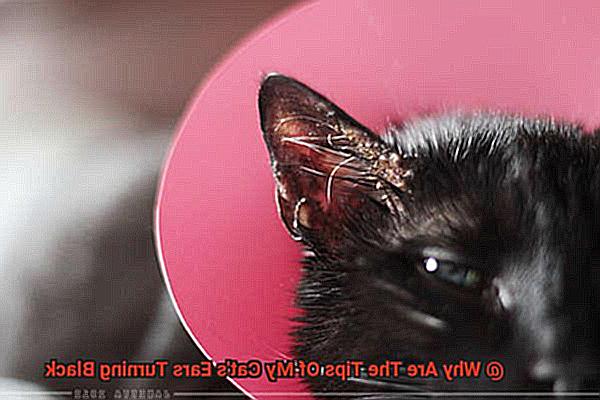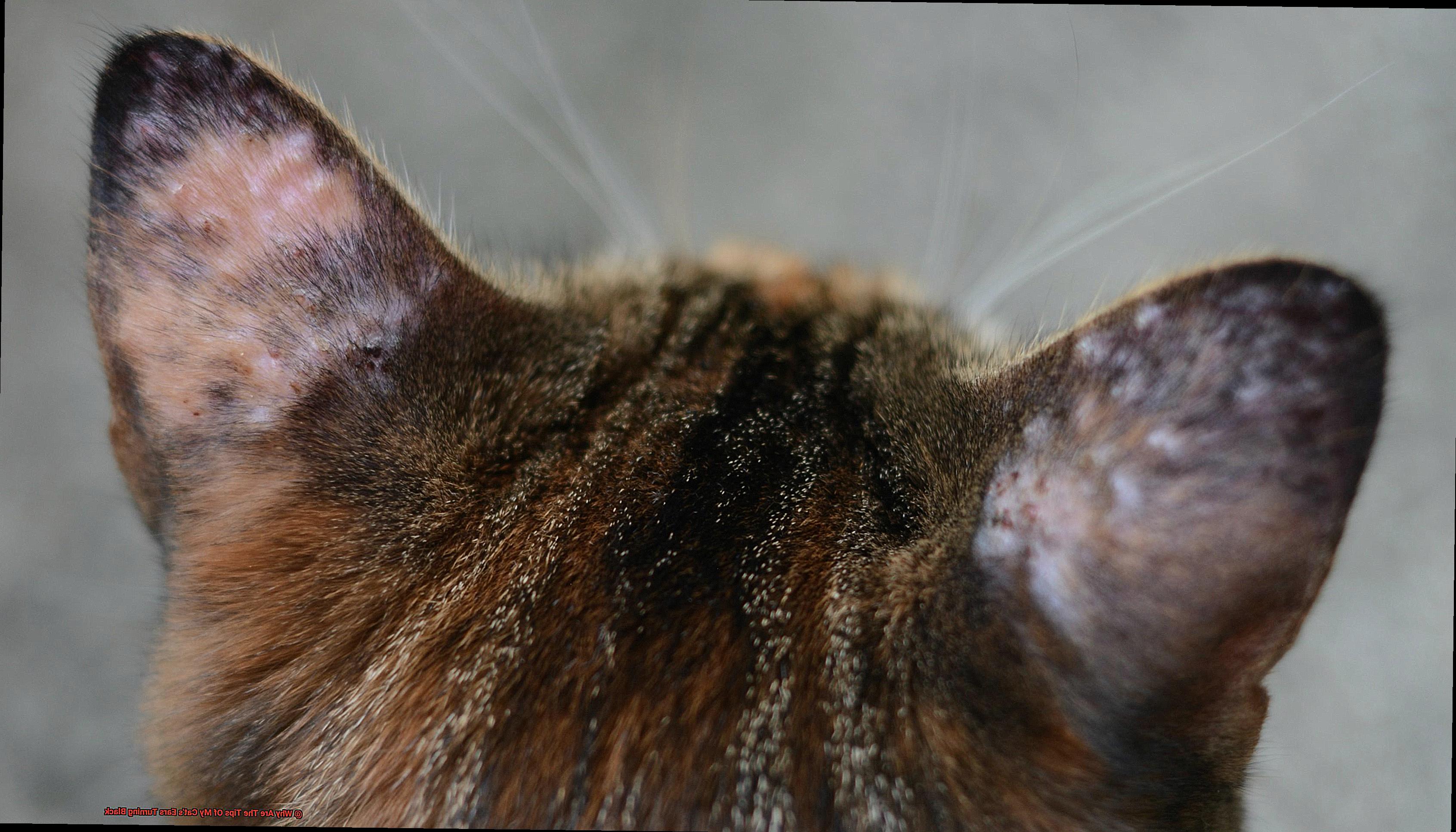Have you noticed a change in your feline friend’s ears? Perhaps the tips are turning black, and you’re not sure what to make of it. It can be a startling sight, especially if your cat has always had light-colored ears. But fear not, we’re here to shed some light on this curious phenomenon.
As it turns out, there are several reasons why your cat’s ear tips could be turning black. Some causes are harmless, while others may require a visit to the vet.
Genetics could be one reason for the change in color. Certain breeds of cats, like Siamese and Himalayans, may naturally have black ear tips due to their genetics. In such cases, there’s no need for concern or treatment.
However, if your cat’s ear tips have never been black before, it could be a sign of sun damage. Cats with white or light-colored ears are more susceptible to sunburn and skin damage from exposure to the sun. Over time, this can cause the skin to darken and become discolored.
Another possible cause of black ear tips is a fungal or bacterial infection. If the skin on your cat’s ears is inflamed or irritated, it could lead to discoloration. In such cases, your vet may prescribe medication to treat the infection and alleviate any discomfort your cat may be experiencing.
In this blog post, we’ll delve deeper into the various causes of black ear tips in cats and explore possible treatments that can help resolve them quickly and safely. So stick around as we unravel this intriguing mystery.
Ear Mites: A Common Cause of Black Ear Tips
Unfortunately, ear mites are a common issue that can cause a range of problems and discomfort for your furry companion. In this blog post, we’ll delve into the symptoms, causes, and treatments of ear mites in cats that can lead to black ear tips.
Symptoms
One of the most common signs of ear mites is black, crusty debris on the tips of your cat’s ears. This accumulation is actually a combination of dried blood, wax, and mite feces. Additionally, cats with ear mites may scratch their ears excessively or shake their heads frequently due to irritation and inflammation.
Causes
Ear mites are tiny parasites that feed on the wax and oils inside your cat’s ear canal, leading to inflammation and discomfort. Outdoor cats or those who come into contact with other infected animals are at a higher risk of contracting ear mites. Moreover, young kittens and cats with compromised immune systems are more susceptible.
Diagnosis
If you notice any symptoms of ear mites, it’s essential to take your cat to the vet for a proper diagnosis. The vet will use an otoscope to examine your cat’s ear canal for tiny white dots moving inside the ear, which indicate the presence of ear mites.
Treatment
Treatment typically involves applying an anti-parasitic medication directly into the cat’s ear canal that kills the mites while soothing any inflammation or irritation. In severe cases, oral medications may also be prescribed. It’s crucial to treat all cats in your household to prevent reinfestation and keep them healthy.
Prevention
Regular cleaning of your cat’s ears with a gentle cleanser is one way to prevent ear mites. Keeping your cats indoors can also reduce their exposure to other infected animals. Regular check-ups with a veterinarian can also help detect and treat ear mites early before they cause significant damage.
Sunburn: Another Possible Reason for Black Ear Tips
Seeing your furry friend’s ear tips turn black can be unsettling. While there are several reasons why this may happen, one possible cause is sunburn. Yes, you heard that right. Just like humans, cats can get sunburnt too, and their ears are especially susceptible to it. In this post, we will discuss why sunburn can cause black ear tips in cats and what you can do to protect your feline friend.
Why do Cat’s Ears Turn Black from Sunburn?
Cats with white or light-colored fur are more prone to sunburn because the skin on their ears is thin and has little to no hair covering it.
Prolonged exposure to the sun’s harmful rays can damage the skin cells and cause them to darken, leading to black ear tips in cats.
Sunburn can be painful for cats and if left untreated, it can lead to more severe health issues such as skin cancer.
How to Protect Your Cat from Sunburn?
The best way to protect your cat from sunburn is to avoid exposing them to direct sunlight during the hottest parts of the day, typically between 10 am and 4 pm.

If your cat does go outside during this time, make sure they have access to shaded areas where they can escape the sun’s rays.
You can also provide them with a comfortable bed or mat under a tree or patio umbrella.
Another way to protect your cat’s delicate ears from sunburn is by applying pet-safe sunscreen before they go outside.
However, not all sunscreens are safe for cats, so it’s essential to consult with your veterinarian before using any product on your cat.
It’s also important to follow the instructions carefully when applying sunscreen and avoid getting it in their eyes or mouth.
If your cat’s ears have already turned black due to sunburn, it’s crucial to keep an eye on them for any signs of infection or inflammation.
If you notice any redness, swelling, or blistering on your cat’s ear tips, it’s essential to take them to a vet for an examination and treatment. Your veterinarian can provide medication to alleviate your cat’s discomfort and prevent further damage to their skin.
Allergies and Infections as Causes of Black Ear Tips
Before you panic, know that it’s a common issue with a few possible causes. One of the most common reasons for black ear tips in cats is allergies, which can be triggered by various factors like food, pollen, and flea bites. When a cat experiences an allergic reaction, it causes inflammation and irritation in the ear canal, leading to a buildup of wax and debris that eventually turn the tips of the ears black.
Another possible cause of black ear tips is infections, which can be caused by bacteria or yeast. Ear infections can be extremely painful for cats and may result in discharge from the ears, head shaking, and scratching. If left untreated, an ear infection can lead to permanent damage to the ear canal and even hearing loss.
Prevention is always better than cure when it comes to allergies or infections that may lead to black ear tips in cats. Ensure that your cat’s surroundings are clean and free from allergens like dust and mold. Use recommended flea prevention products to keep your cat safe from flea bites. Make sure to clean your cat’s ears regularly with a gentle cleanser to avoid wax buildup and dirt.
If you suspect that your cat may have an allergy or infection causing black ear tips, don’t waste any time and take them to a veterinarian right away. A thorough examination will help determine the underlying cause of the problem, and they may prescribe medication or recommend changes to your cat’s diet or environment to manage symptoms and prevent future occurrences. Your cat’s health should always be a top priority, so don’t hesitate to seek professional help.
Black ear tips in cats can be caused by allergies or infections. Taking steps towards prevention through proper hygiene and maintenance is essential in keeping your cat healthy and happy.

If you suspect any issues with your cat’s ears, visit a veterinarian for proper diagnosis and treatment.
Skin Cancer as a Rare Cause of Black Ear Tips

Cats are known for their curious nature and independent personality, but when it comes to their health, it’s important to be vigilant. One concerning change pet owners may notice is black ear tips. While this may be caused by ear mites or sunburn, it’s crucial to understand that skin cancer can also be a rare but serious cause of black ear tips in cats.
Skin cancer can develop on any part of a cat’s body exposed to the sun, including their ears. Cats with white or light-colored fur are more susceptible to skin cancer because they have less pigment to protect them from the sun’s harmful UV rays. Squamous cell carcinoma is the most common type of skin cancer in cats and typically presents as a red, scaly or ulcerated lesion on the ear tip.
Symptoms of skin cancer in cats can include black and crusty ear tips, unusual bumps or lumps on their skin, or discoloration and swelling of the affected area. If you notice any of these symptoms, it’s important to take your cat to the vet for an evaluation as soon as possible. Early detection and treatment can greatly improve the prognosis for cats with skin cancer.

Treatment for skin cancer in cats varies depending on the type and severity of the cancer, but it may involve surgical removal of the affected area, radiation therapy, or chemotherapy. Your veterinarian will work with you to develop a treatment plan that is best suited for your cat’s individual needs.
Prevention is key when it comes to skin cancer in cats. You can help protect your cat from developing skin cancer by limiting their time outside during peak sun hours and providing plenty of shaded areas. Applying pet-safe sunscreen to their ears and nose can also help protect them from the sun’s harmful UV rays.
Regular check-ups with your vet can also help detect any signs of skin cancer early on. During these visits, your vet will examine your cat’s ears and skin for any changes or abnormalities.
Black ear tips in cats can be caused by skin cancer, a rare but serious condition that can affect any part of their body exposed to the sun. As pet owners, it’s important to be vigilant of any changes in your cat’s appearance and seek veterinary attention immediately if you notice any symptoms.
The Importance of Seeking Veterinary Attention
That’s why it’s crucial to pay attention to any changes in their physical appearance, such as the tips of their ears turning black. If you notice this symptom, seeking veterinary attention should be a top priority.
Blackening of the ear tips in cats can be caused by a variety of underlying medical conditions that require prompt treatment. Ear mites, for example, are a common cause that can lead to intense itching and irritation, resulting in inflammation and damage to the skin.
Infections caused by poor hygiene or a weakened immune system can also result in blackening of the ear tips. Allergies triggered by environmental factors or certain foods can also cause inflammation and irritation that leads to darkening.
While rare, skin cancer can present as darkened areas on the skin. Therefore, it’s essential to consider this possibility if you notice your cat’s ear tips turning black. Early detection and treatment can make all the difference in treating this serious condition.
Your veterinarian is your best resource for diagnosing the underlying cause of blackening in your cat’s ear tips and providing appropriate treatment. Ignoring this symptom could lead to more serious health problems down the line, so don’t hesitate to seek veterinary attention right away.
Remember, when it comes to your pet’s health, there’s no such thing as being too cautious. So if you notice any changes in your cat’s appearance or behavior, including blackening of the ear tips, seek veterinary attention immediately.
nUGjxaEW2N8″ >
Treatments for Black Ear Tips
While it may be alarming, this is a common issue in felines and can be caused by a variety of factors. As an expert on treatments for black ear tips, I’m here to help guide you through the various treatment options depending on the underlying cause.
Step One: Identifying the Cause
The first step in treating black ear tips is determining the root cause. If it’s an infection, your veterinarian may prescribe antibiotics or antifungal medications. Ear mites are also a common culprit, and medication specifically designed to kill them will be prescribed. It’s important to treat all cats in the household, even if they don’t show any symptoms of ear mites.
Step Two: Sunburn
Did you know that sunburn can also cause black ear tips in cats? It’s essential to keep your feline friend indoors during peak sun hours and provide shaded areas when outside. Applying sunscreen specifically formulated for cats to sensitive areas such as the ears can also help.
Step Three: Allergies
Allergies are another potential cause of black ear tips. The veterinarian may recommend minimizing exposure to potential allergens or prescribe medications such as antihistamines or corticosteroids.
Step Four: Hormonal Issues
In rare cases, hormonal issues like hyperthyroidism can lead to black ear tips. Treating the underlying condition will generally resolve the issue with the ear tips.
Step Five: Patience and Follow-Up
It’s important to remember that treating black ear tips takes time and patience. Follow-up appointments with your veterinarian may be necessary to monitor progress and adjust treatment plans as needed.
Don’t let those black ear tips cause you undue stress. With proper diagnosis and treatment, your feline friend’s ears will be back to their natural color in no time.
Also Read: Black Smoke Maine Coon: Everything You Need to Know
Conclusion
In summary, the causes of black ear tips in cats are diverse and can range from genetics to skin cancer. While some reasons may not be serious, others require immediate veterinary attention to prevent further discomfort or damage to your beloved pet.
Before starting any treatment, it’s critical to identify the underlying cause of the blackened ear tips. Treatment options vary and may involve medication, lifestyle changes, or surgery.
Prevention is always better than cure when it comes to black ear tips in cats. Regular cleaning of your cat’s ears with a gentle cleanser can help prevent wax buildup and dirt that can lead to infections or allergies.
Keeping your cat indoors during peak sun hours and providing shaded areas outside can also help protect them from sunburn. Regular check-ups with your veterinarian can also help detect any issues early on before they become more serious.







